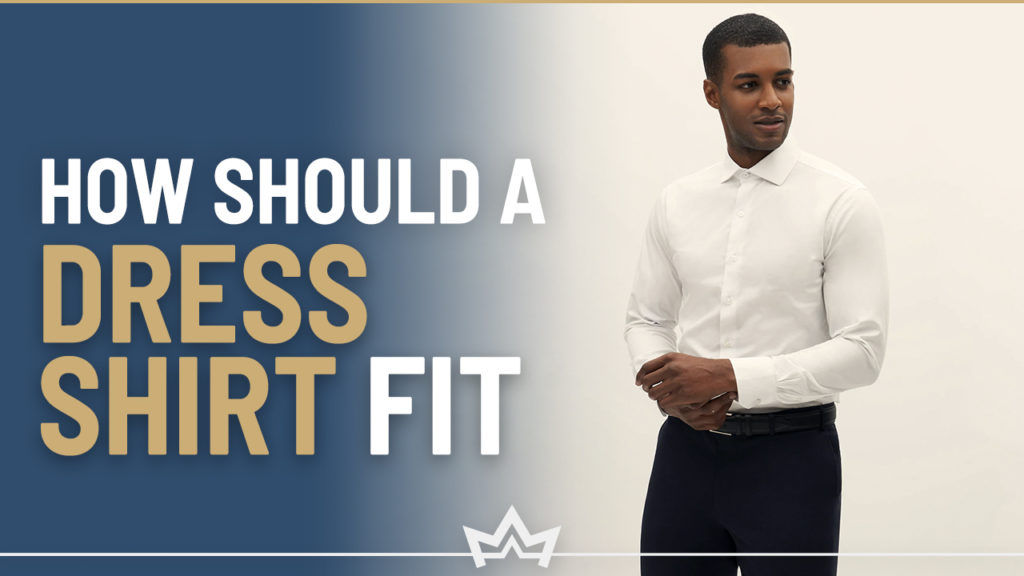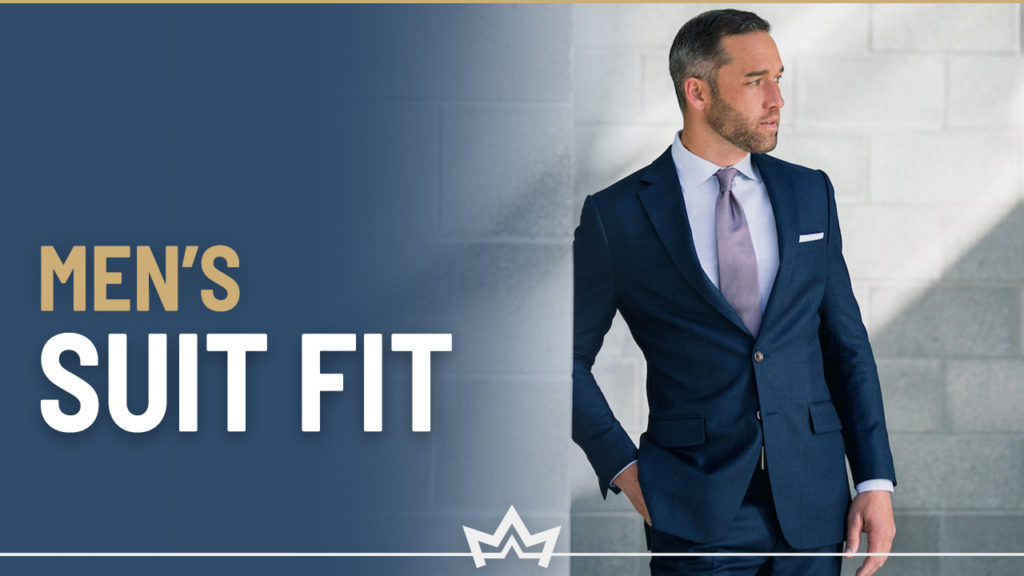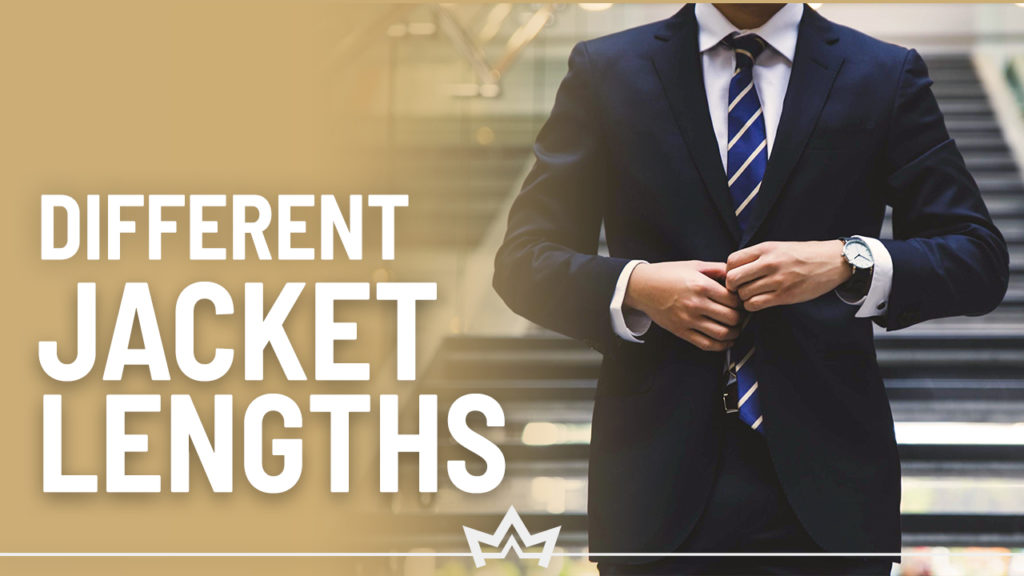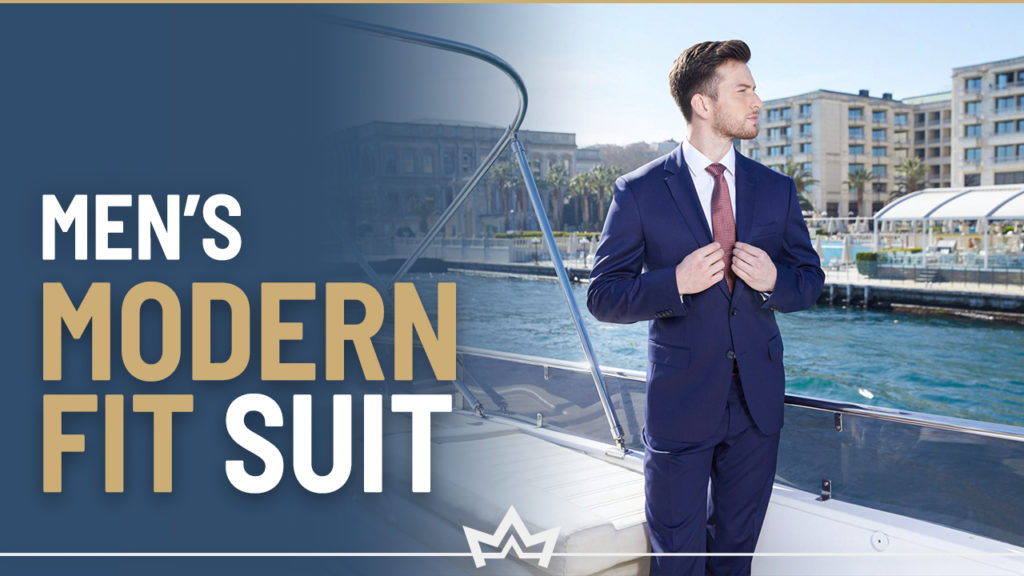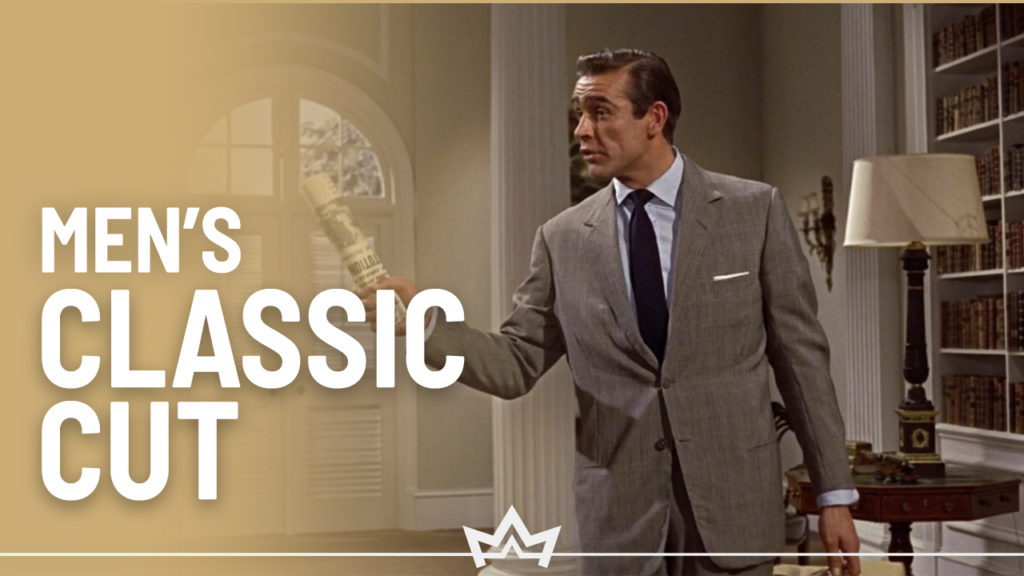The unduly tight or loose parts are critical for the dress shirt’s fit, comfort, and appearance.
Comfort and looks are easy to gauge. But identifying the right fit and what’s tight or loose is what matters the most.
I will cover the right dress shirt fit and help you wear a dress shirt with confidence.
What is a Dress Shirt Fit & Why It’s Important?
Unlike popular belief, the slim, modern, or classic fit doesn’t define the actual shirt fit.
Instead, these terms represent the shirt cuts and explain different shirt style variations.
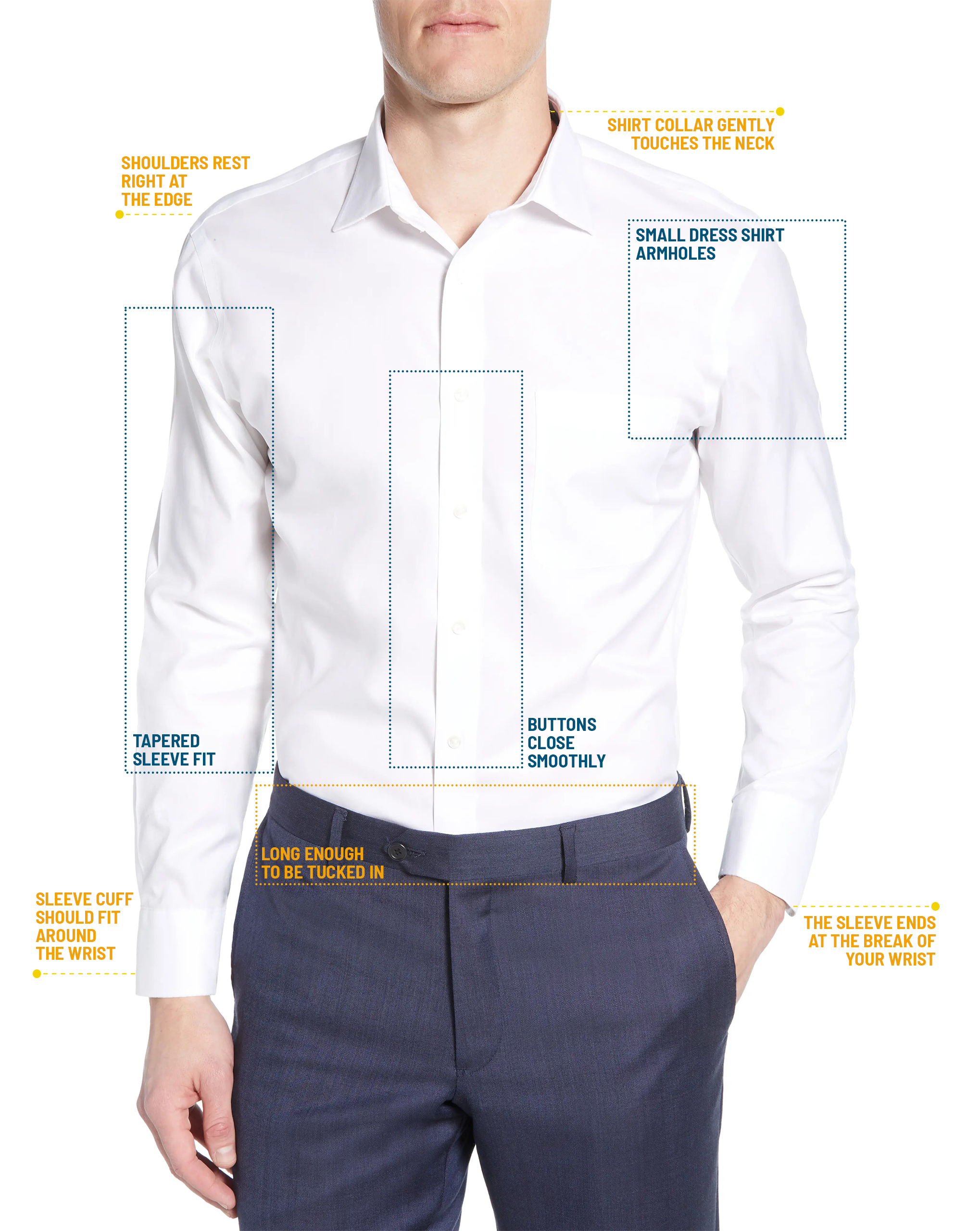
The way a dress shirt should fit is all about complementing your body.
A proper fit aims to provide comfort and an appropriate range of motion to body areas like the collar, torso, and arms.
Nonetheless, a perfect dress shirt fit is vital for myriads of reasons.
First, it will always affect your appearance, comfort, and confidence.
Men often compromise the right shirt fit with suits, expecting the suit to cover the shirt.
But it’s even more critical when you wear a suit over your shirt, as a poor-fitted dress shirt can even harm the suit’s fit.
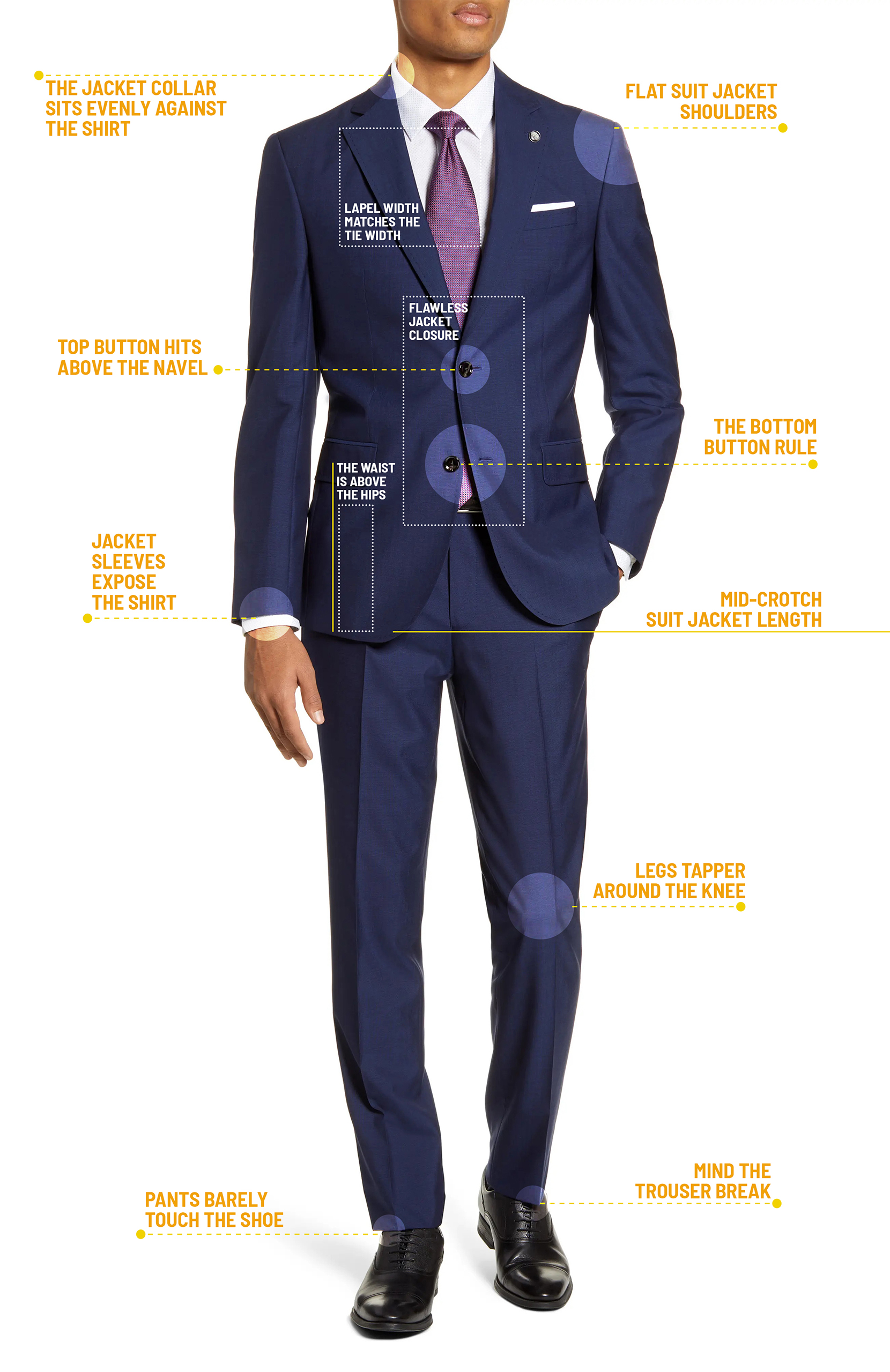
Finally, proper fit is the way to get the most out of your money, as the shirt will last longer.
The Shirt Collar Gently Touches Your Neck
Many brands only use the collar size to determine the dress shirt’s fit. Therefore, it becomes a prerequisite to get it right.
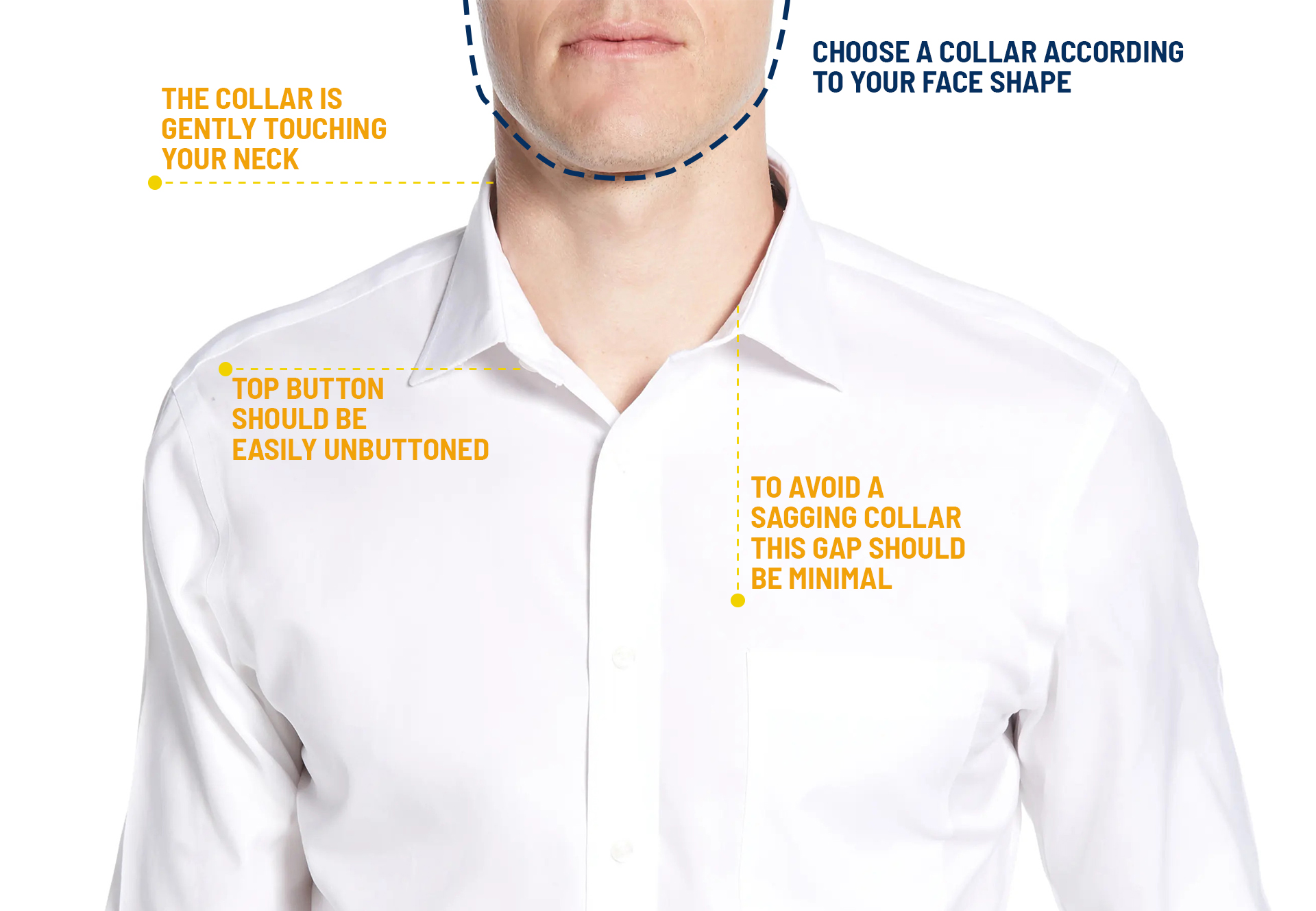
The subjective and best way to test the dress shirt collar fit is how it feels on the neck.
A well-fitted collar that is gently touching your neck. Likewise, the ease of sliding two fingers between the neck and the collar with the top button closed tests the right collar size.
Any strain on the neck or the feeling of being choked indicates a tight fit.
A loose collar creates a gap between the neck and collar, causing the collar to sag. In addition, loose collars look out of proportion to the shoulders and the face.
That said, always pay attention to the shirt collar type. A good collar should proportionally frame your face.
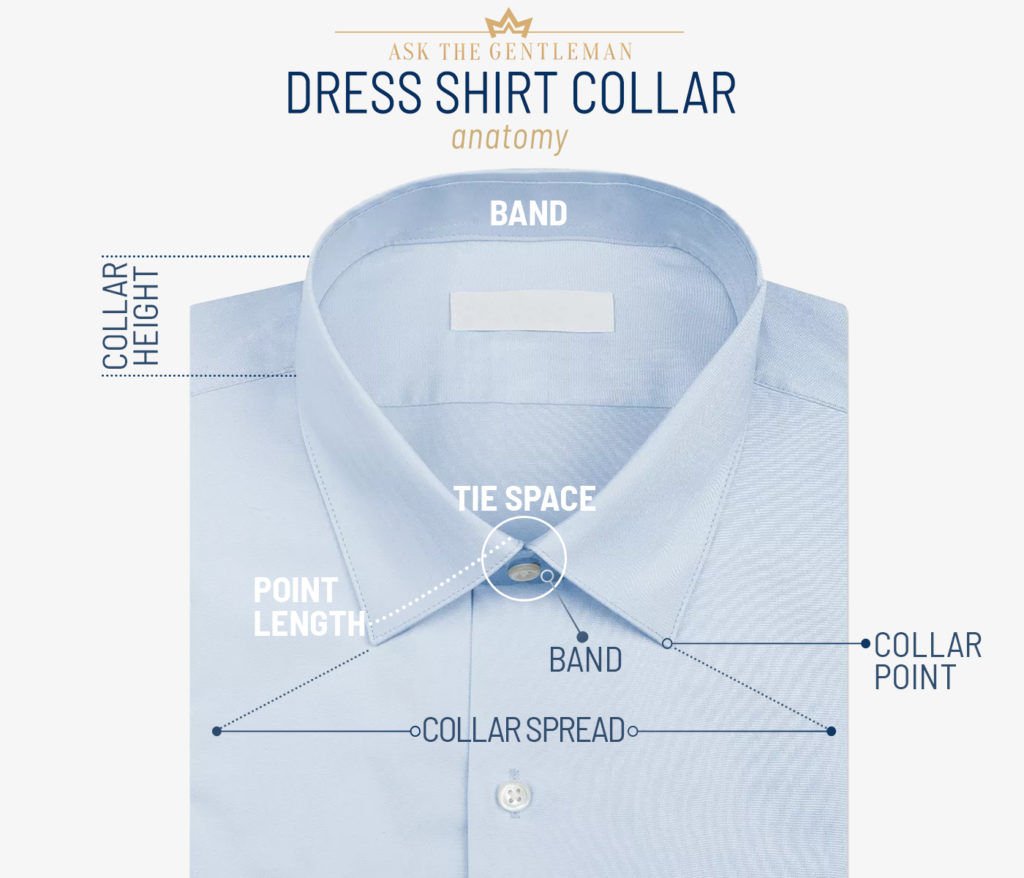
Conversely, unbalanced collar proportions make your face look unusually big or small and clearly indicate a bad fit.
The Shoulders Rest Right at the Edge
The shoulder length is measured via the horizontal shoulder seams on the back, called the Yoke.
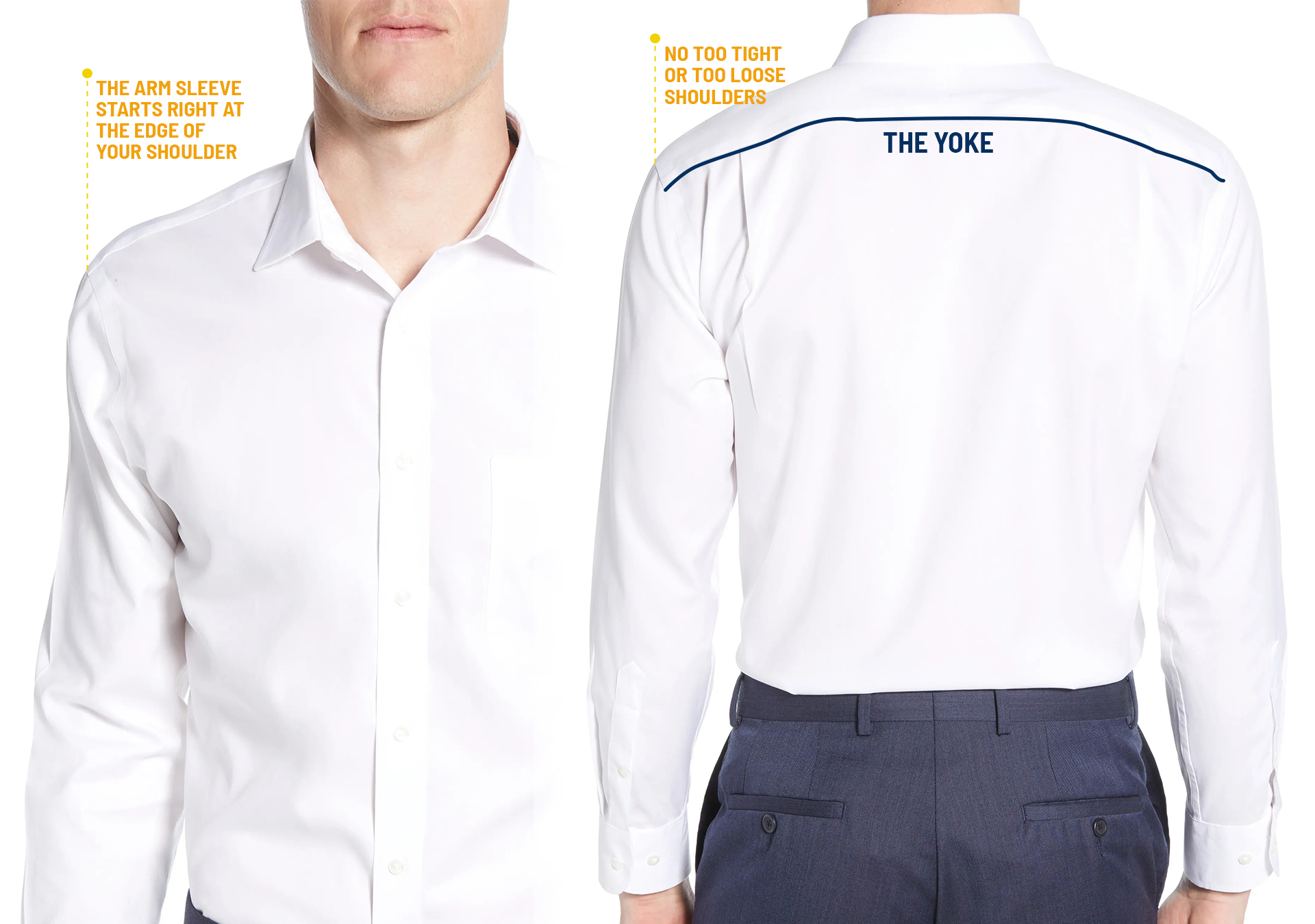
The ideal shoulder fit must end right at the outer edge of your natural shoulders. The arm sleeve will smoothly start from the actual shoulder.
A tight shirt’s shoulder puts pressure on the front of the shirt, limiting shoulder and arm movements.
Similarly, upward sleeve displacement creates wrinkles, suggesting tight shoulders.
On the other hand, the loose shirt’s shoulders don’t burden the movements but look sloppy. Shoulders on an ill-fitting shirt also appear unnecessarily broad and asymmetrical.
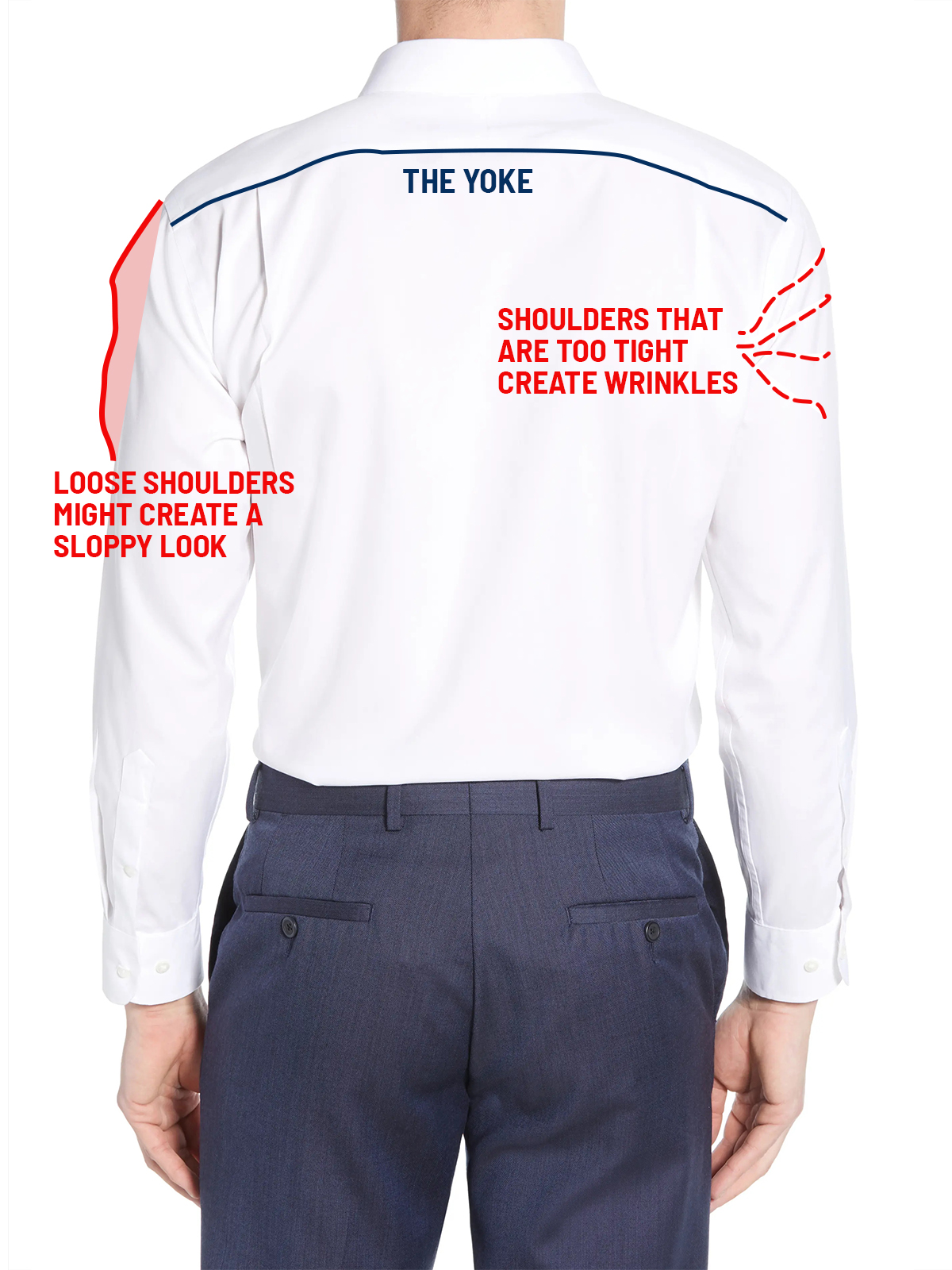
Most off-the-rack shirts’ Yoke corresponds to the collar size or may slightly vary with the shirt cut.
But generally, you don’t have much leverage with these ready-to-wear shirts.
So, people with broad or uneven shoulders usually find it quite difficult to find properly fitting shirts.
Proper Dress Shirt Torso Fit Allows Buttons to Close Smoothly
Everything from the chest to the waist comes under the torso.
The torso fits properly if you can close all buttons with minimum effort and strain and without excess fabric on the sides.
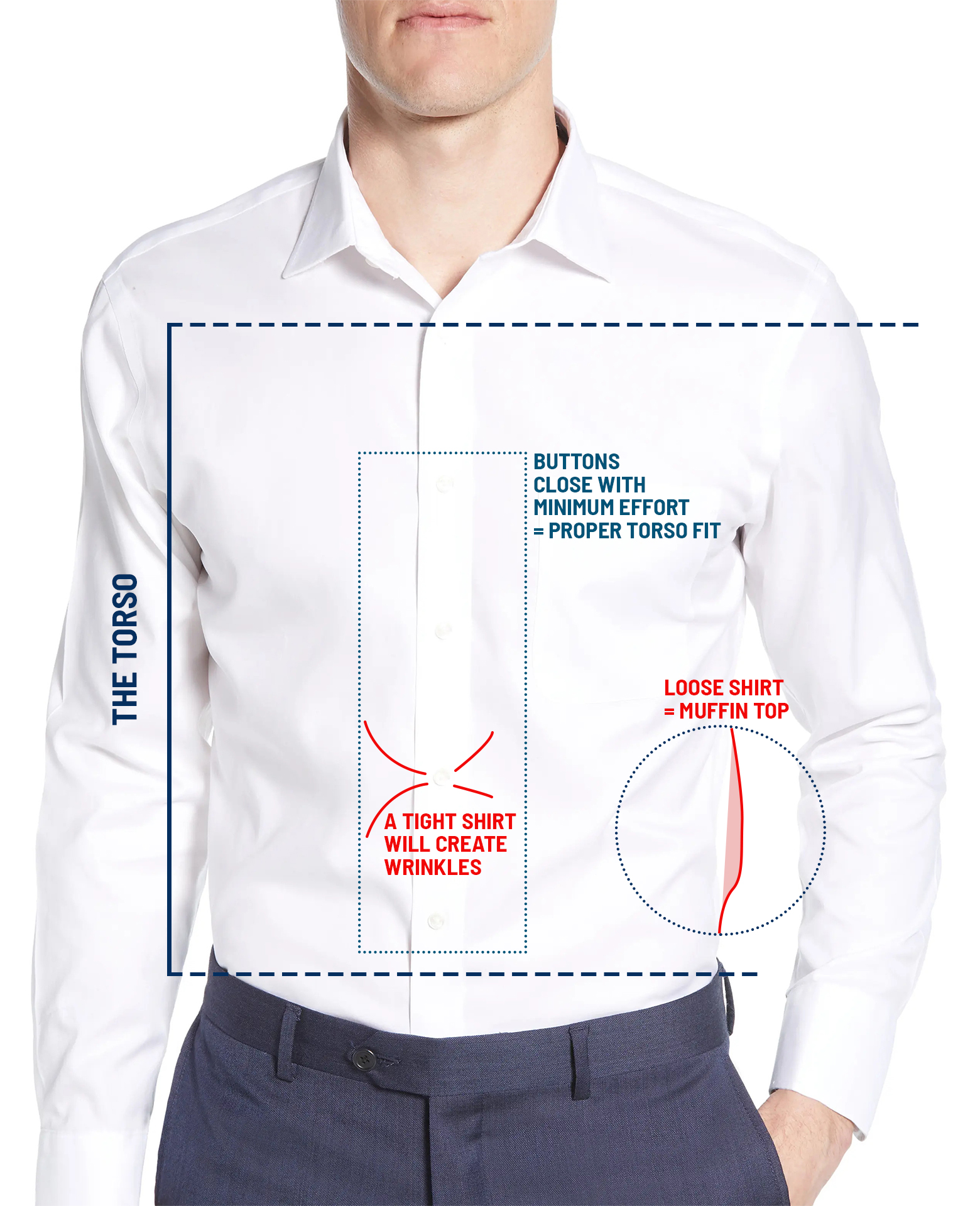
The shirt is too tight if it doesn’t let the buttons close neatly. This may be extremely noticeable with arm movements.
Similarly, a loose shirt causes sagging on the fabric around your waist area and creates a muffin top. In that case, proper tapering is required for the waist to fit right.
However, having excess fabric in the waist can benefit people with belly fat, as it evens up to the fatty abdomen.
In other cases, a shirt with a wide chest and narrow waist will be the best. This not only provides comfort but creates a pleasing silhouette.
The Dress Shirt is Long Enough to be Tucked In
A proper dress shirt length can go down several inches from the beltline to the mid-crotch and won’t untuck when you raise your arms.
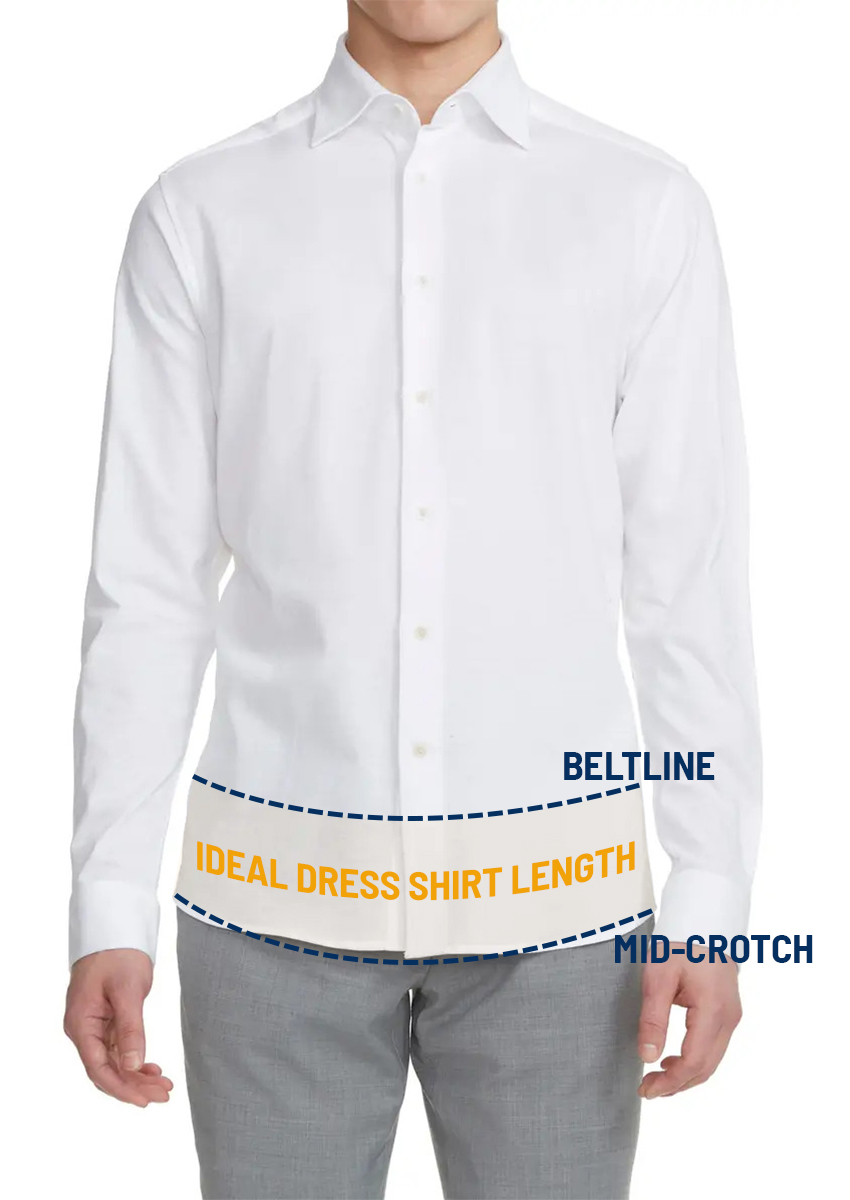
Also, a good-length shirt should never expose the beltline when worn untucked, even with both arms up.
Some shirts are designed to cover only 1-2 inches of the beltline. Although you can wear these untucked, it’s not the right length for a dress shirt.
Similarly, the fabric on the flanks will come out while doing movements.
Contrastingly, some dress shirts cross the mid-crotch area, often formal ones such as those for black-tie events.
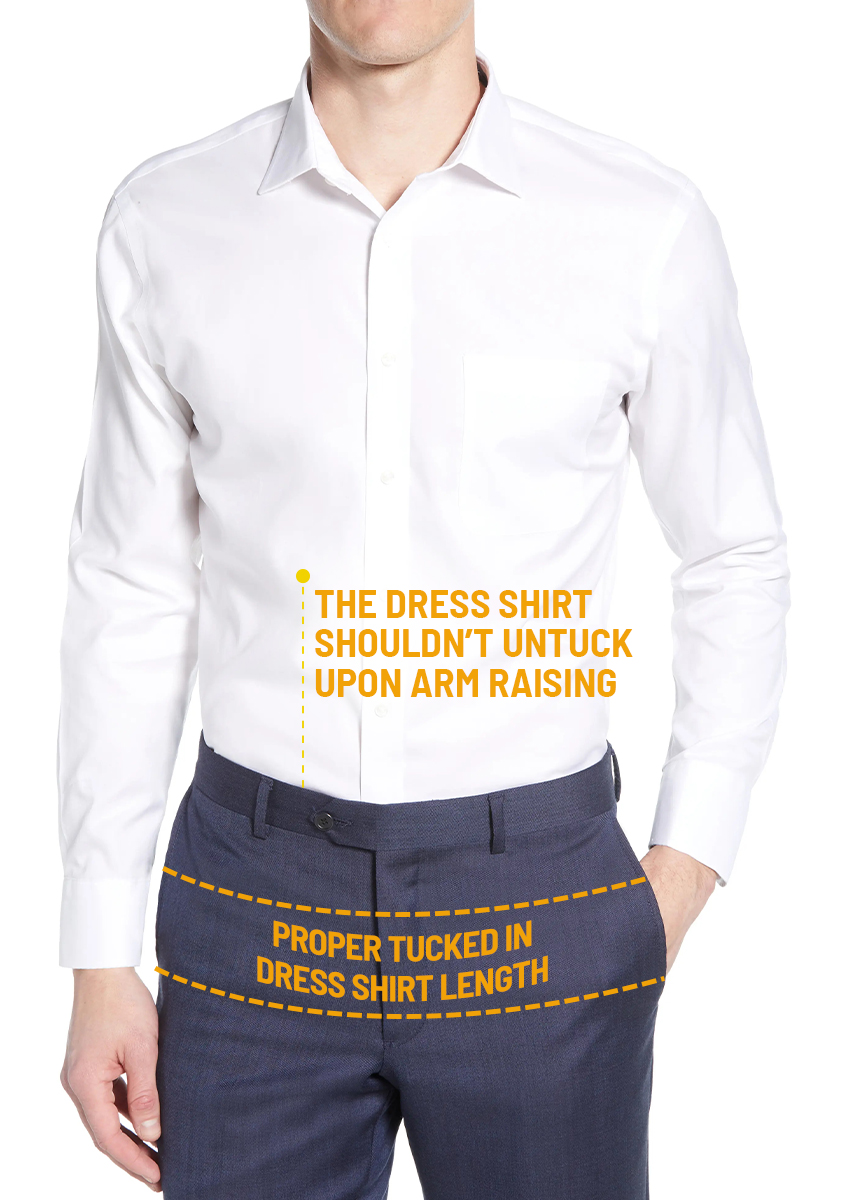
Make sure the excess fabric does not sag at the crotch to create visible wrinkles over the pants.
Of course, you can always get your shirt fixed by a tailor if the shirt hem is long enough to be worn tucked in.
That said, always tuck in your dress shirt with a suit.
Small Dress Shirt Armholes That Do Not Restrict Movement
Armholes affect how the shirt looks on your body and how comfy it feels.
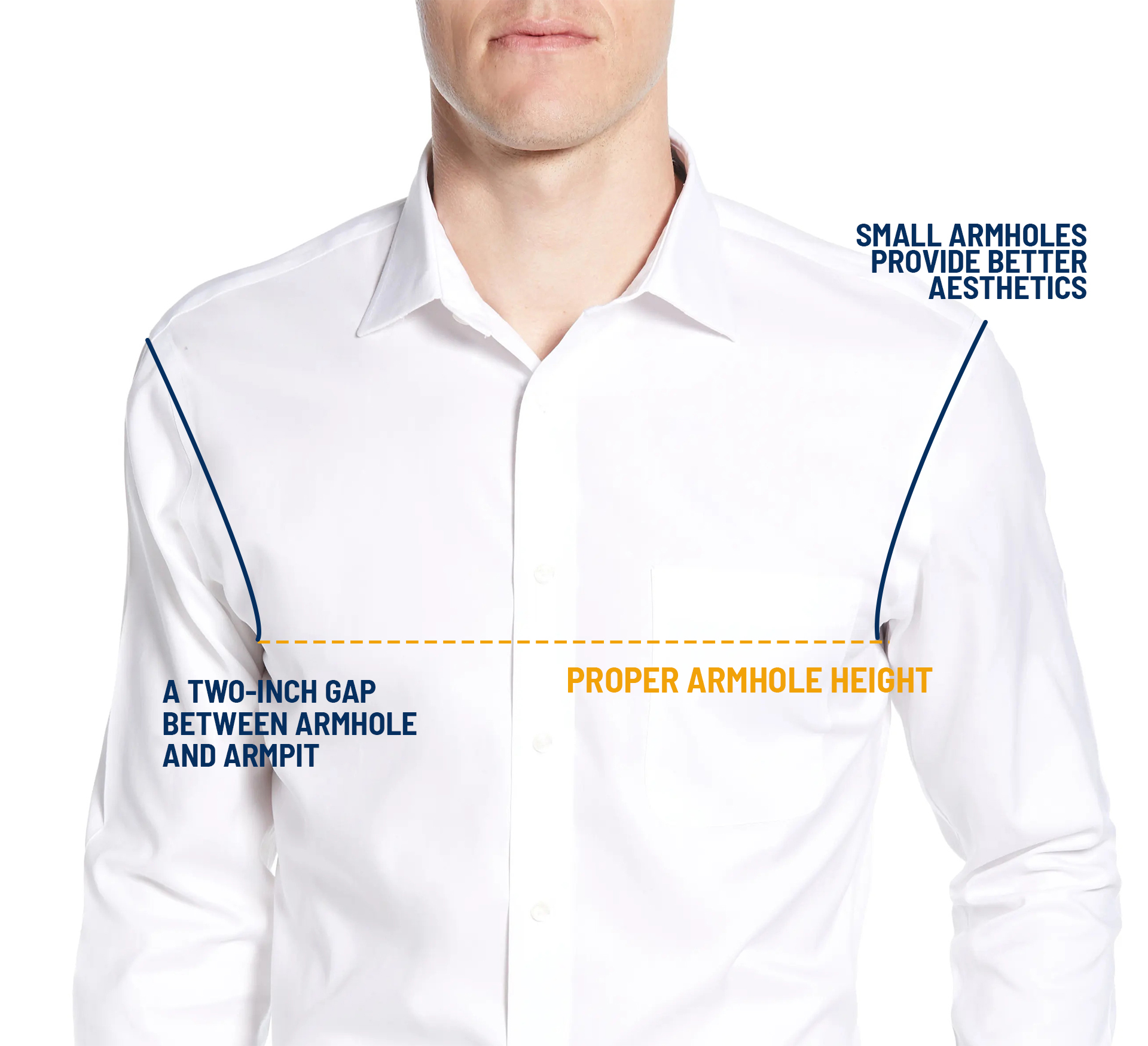
For a perfect fit, dress shirts have small armholes that provide a good silhouette but still allow easy movements.
The way to test the armhole fit is to reach your hand forward and touch the opposite armhole. There should be no excess fabric or any fabric tension here.
A two-inch gap from the shirt’s armhole to your armpit is best when the arm is straightened.
Sometimes, too-small armholes can look appealing; still, avoid going too extreme. They can easily get sweaty, causing discomfort due to close contact with the skin.
On the other hand, big armholes look saggy and appear as wings when you move your arms.
Tapered Dress Shirt Sleeve Fit
The ideal sleeve fit has two components. The first part is from shoulder to elbow, and the other is from elbow to wrist.
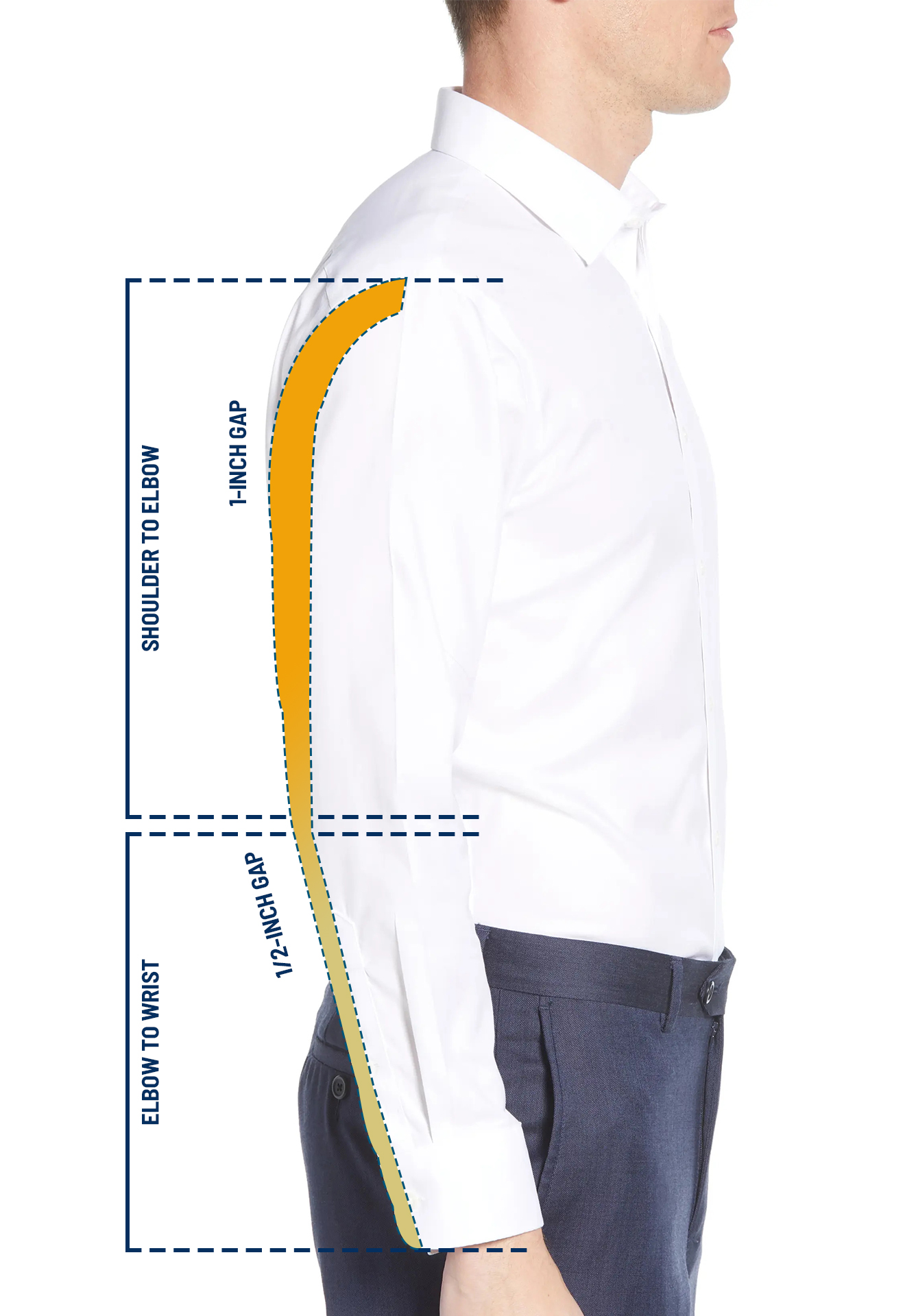
The most timeless style is to have at least a one-inch gap between the biceps and sleeve.
In contrast, this gap narrows about half-inch in the forearm, making the sleeves slightly wider in the biceps.
Tapered shirt sleeves are both comfortable and visually appealing. But you’ll rarely find such perfect tapering with off-the-rack shirts.
In contrast, heavy sleeve attachment to your arm in the biceps area will indicate tight sleeves.
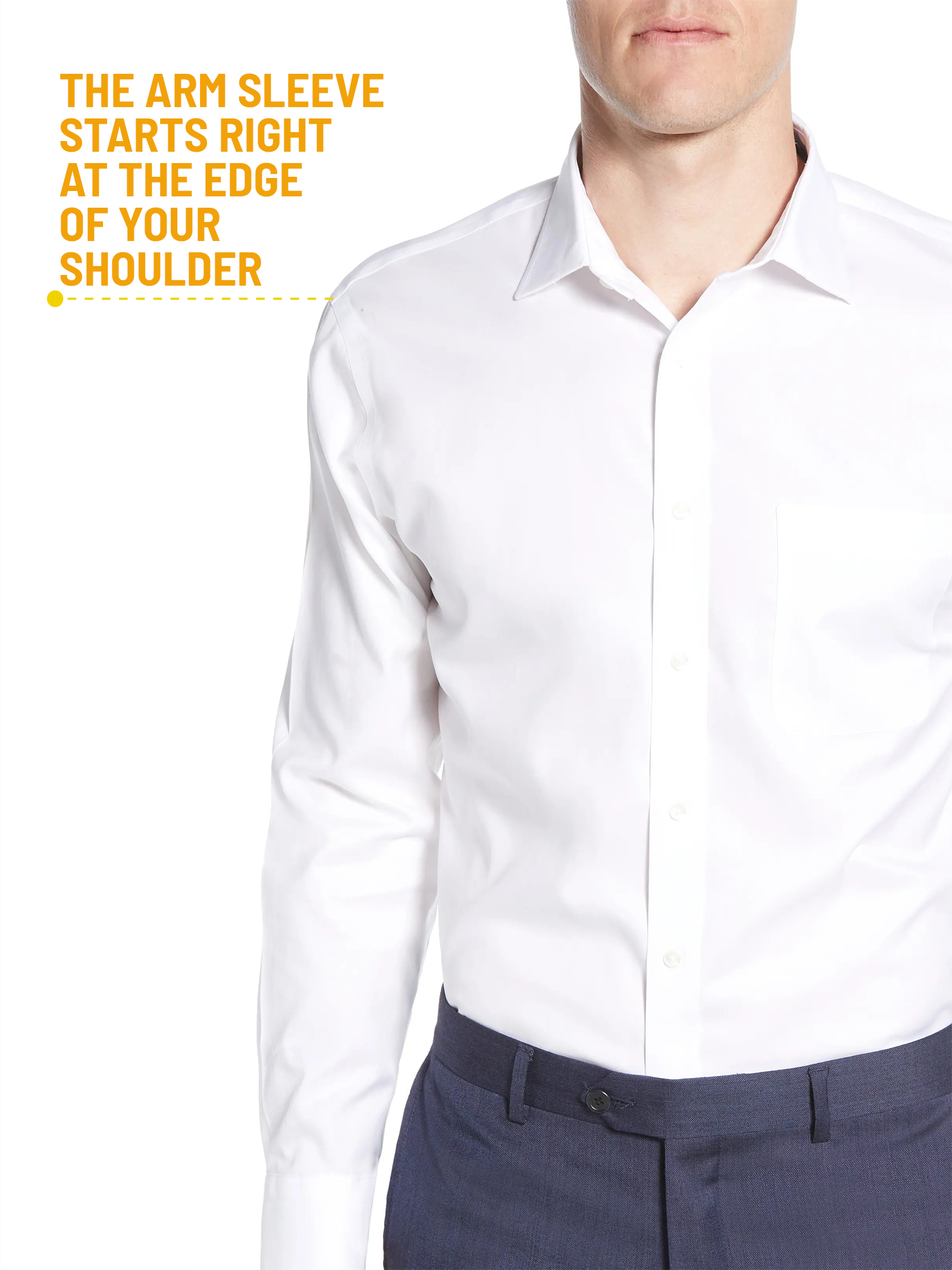
Most men go with tight sleeves that show the arm. Lean gentlemen might get away with such tight sleeves, but bulky men must avoid these.
Similarly, most ill-fitting shirt sleeves are wider. Again, there will be wrinkles and bunching of fabric towards the wrist, so the sleeve will start to weigh down.
The Sleeve Length Ends at the Break of Your Wrist
Not only will the sleeve length impact your comfort, but also the visual appeal of the dress shirt.
Similarly, with suits and tuxedos, a correct sleeve length is inevitable for a well-put-together ensemble.
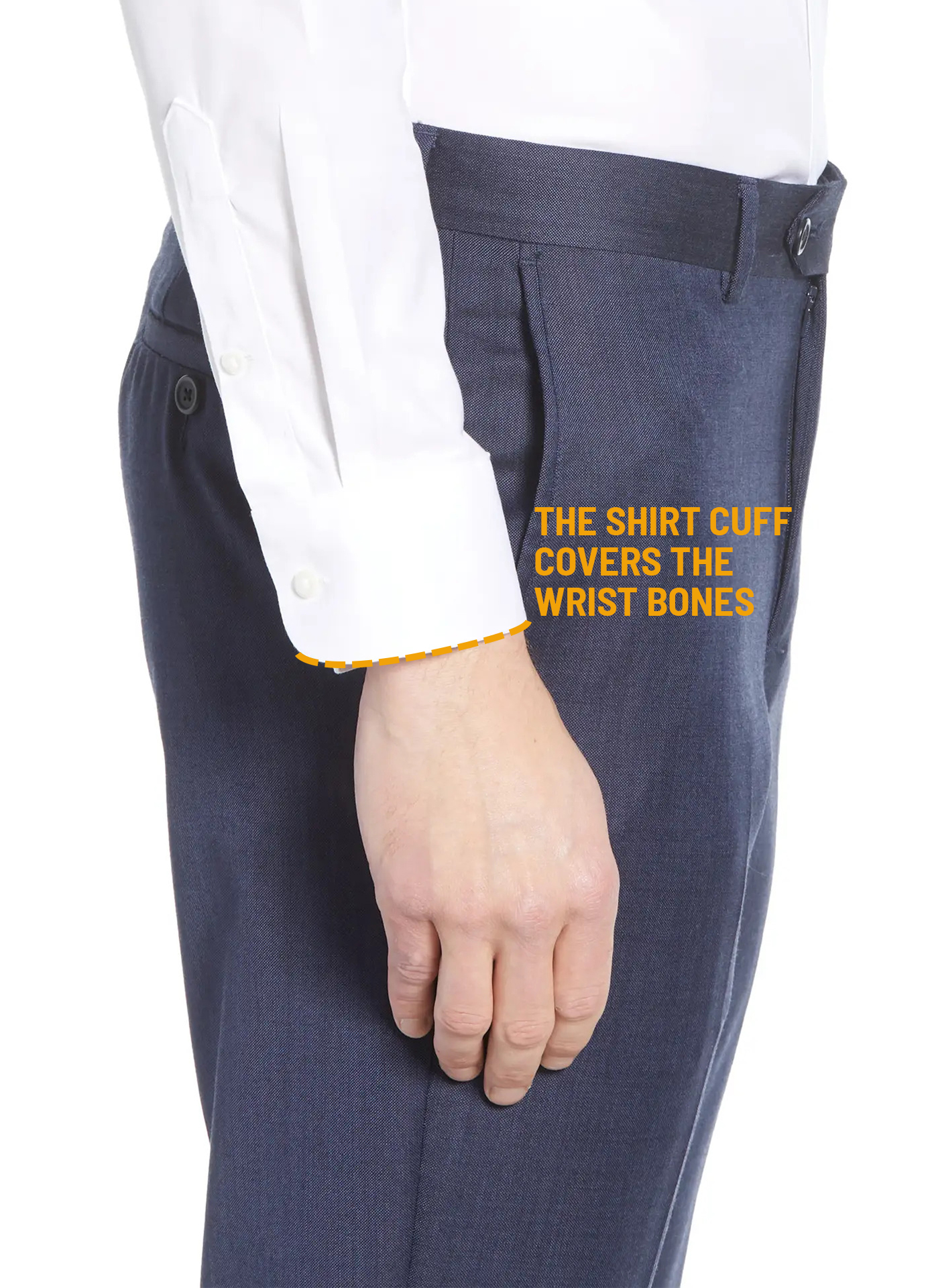
The general rule of proper sleeve length is that it should cover the wrist bones and end at the start of your palm.
This correlates with the suit jacket’s sleeve length just shy of the wrist. As a result, ½ to ¼ inch of the shirt cuff will be exposed.
The sleeve is too short when the wrist is visible. Similarly, if the dress sleeves hide under the jacket sleeve, this will mean short sleeves.
At the same time, the cuff can go way beyond the wrist, indicating a longer sleeve. Longer sleeves usually bunch up at the wrist.
Also, if the sleeves cover your watch completely (instead of partly), they are too long.
Sleeve Cuff Should Fit Around the Wrist
French cuffs and barrel cuffs are two popular options with dress shirts. However, both cuffs will have the same fit.
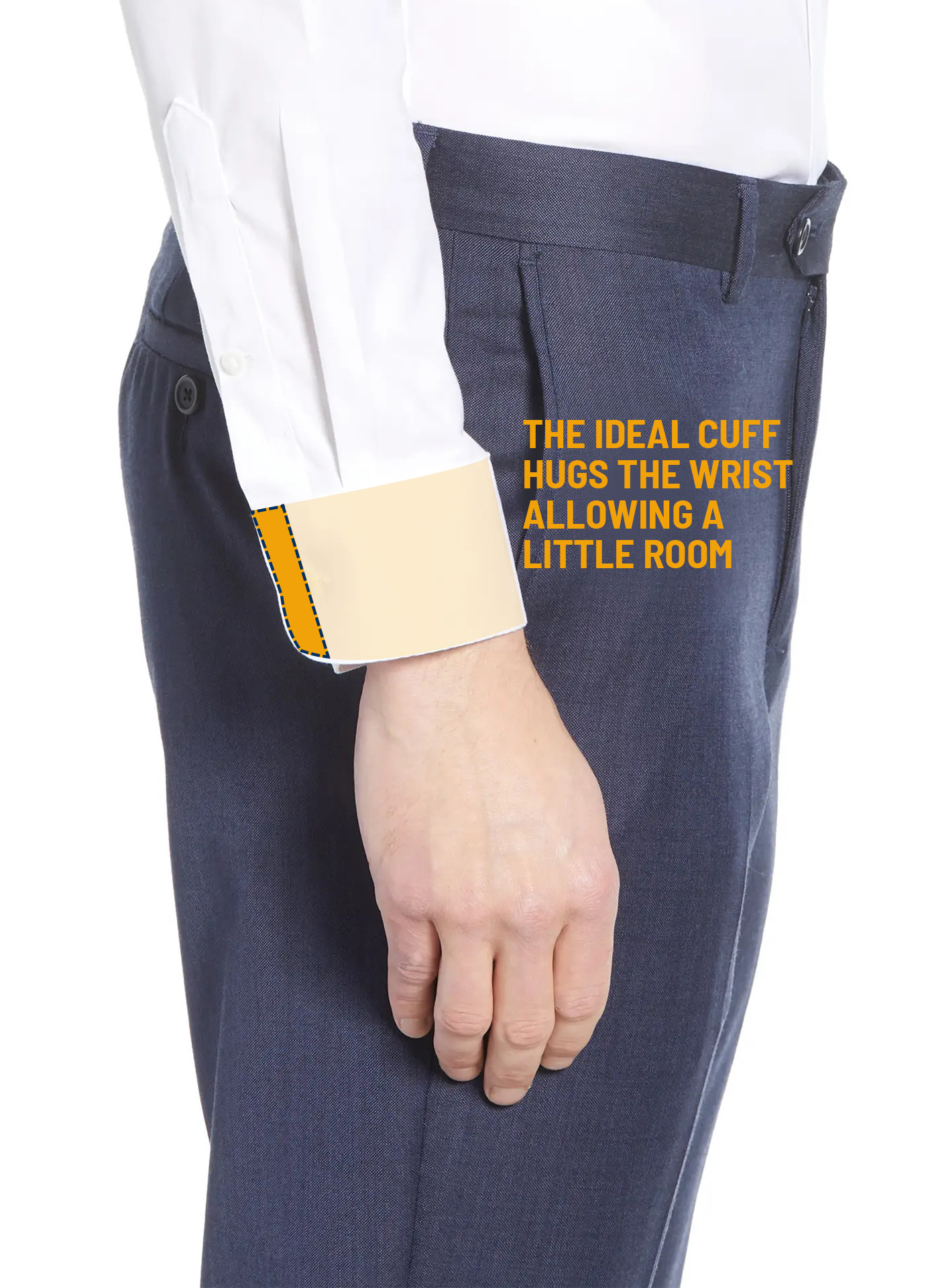
The ideal cuff should stay close to the wrist, allowing a little room. There will be no movement restrictions, and it should never move up the wrist.
Similarly, the cuff should be adequate to accommodate a wristwatch.
I prefer two-button cuffs with leather strap watches. This gives the leverage of easy watch accommodation on the left wrist without compromising the contralateral wrist’s comfort.
Undoubtedly, the cuff size can sometimes be overly tight or loose.
Folds in the cuff as your arm rests on a flat surface or more than two fingers gap will mean a loose cuff.
Similarly, the cuff is too tight if it strangles your wrist or you’re unable to wear a watch because of it.
What are the Different Dress Shirt Fit Types?
Retail dress shirts take most of the things mentioned above into account but in a more generic way.
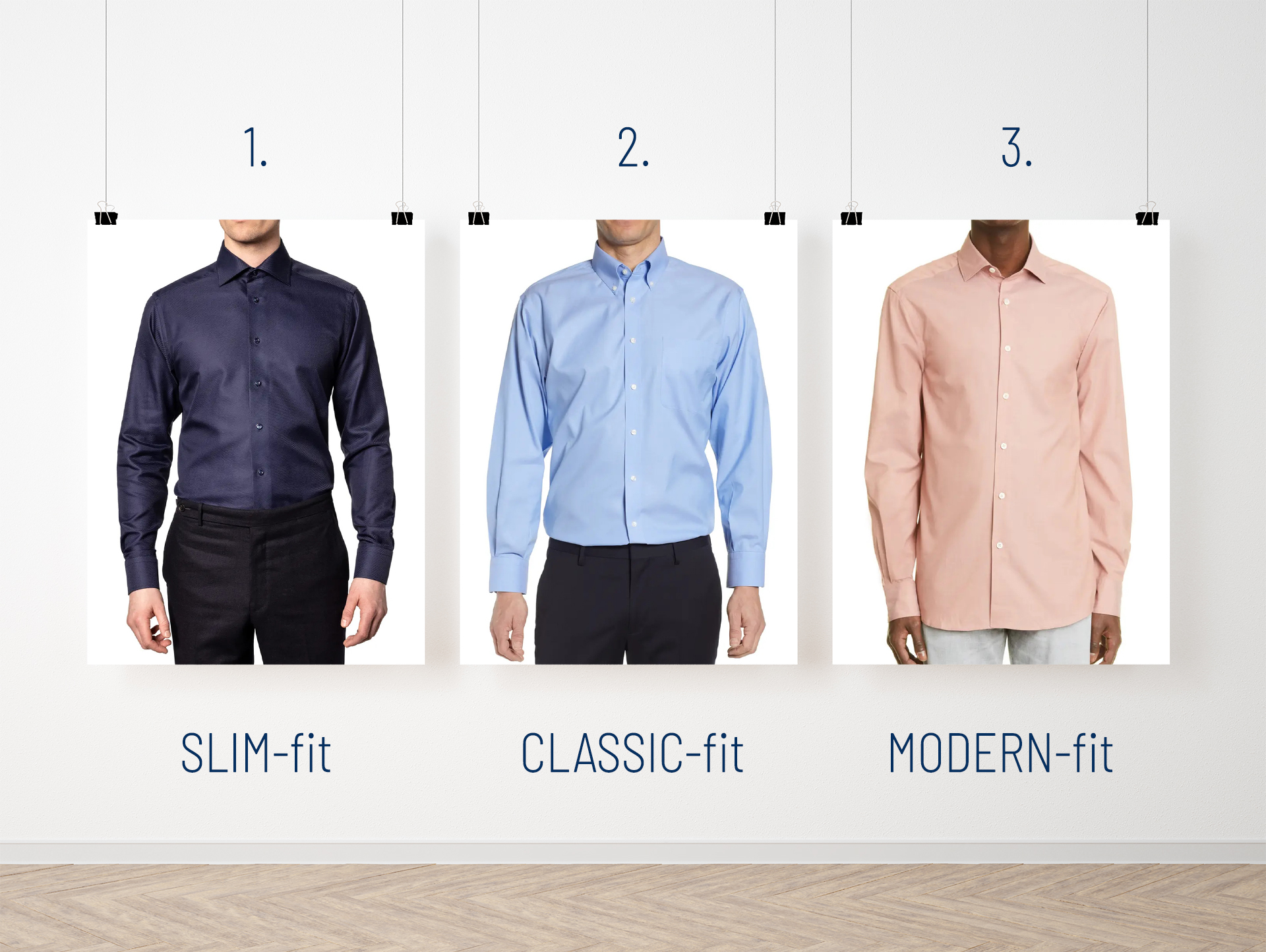
This led to different shirt fit types, each having one central theme.
For example, the classic fit aims to have a roomy cut that seems relaxed and extremely comfortable.
In comparison, slim-fit shirt cuts offer more trimmed-style dress shirts.
Classic-Fit Dress Shirt
The classic fit is the timeless, traditional, and comfortable dress shirt cut. It aims to be roomy and suitable for most body types.
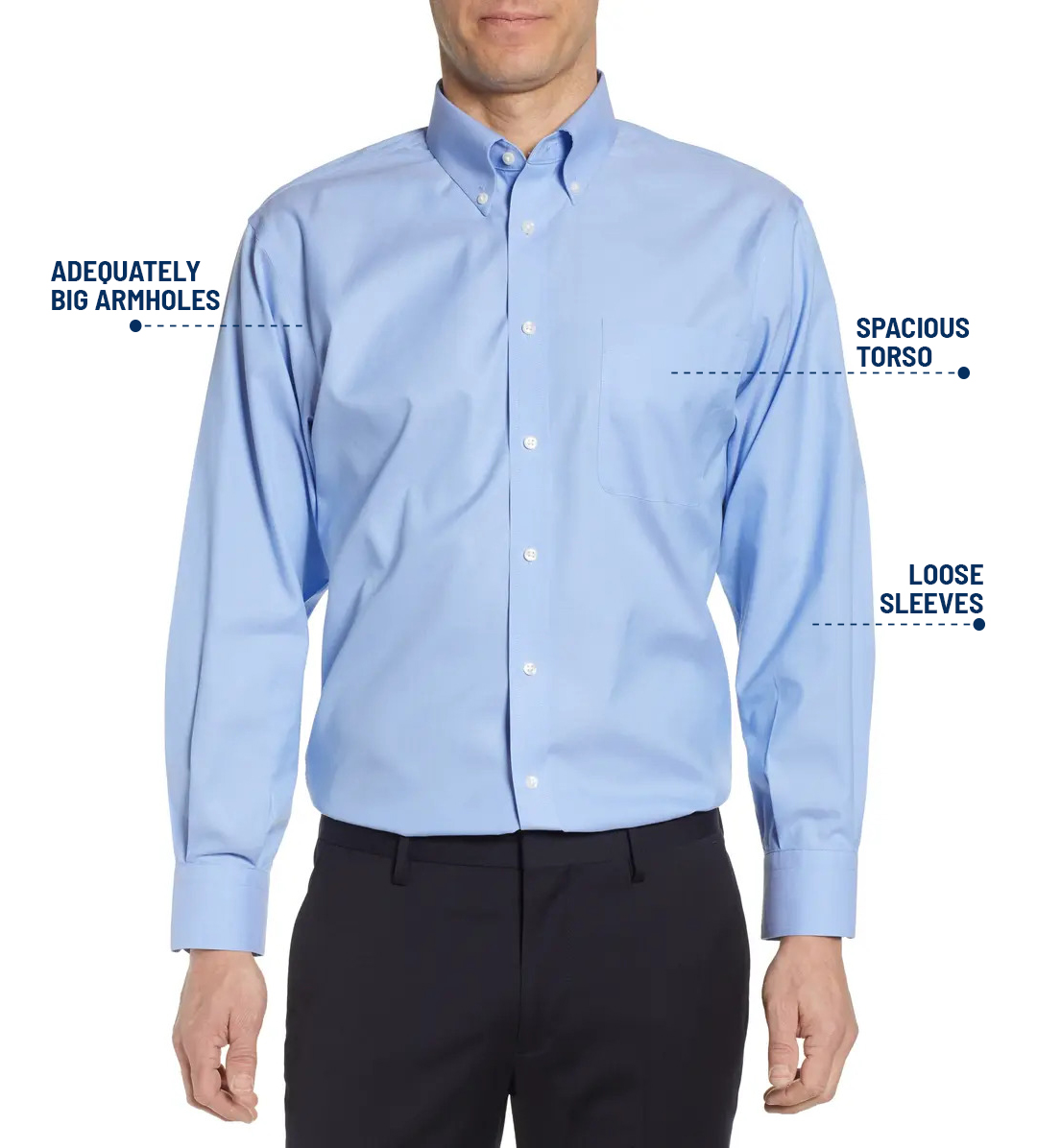
The classic or the regular fit has no practical trimming and, therefore, an effortless cut.
In addition, there is a spacious torso, adequately big armholes, and loose sleeves. But still, the classic-fit dress shirt is not baggy.
The classic-fit dress shirts are now on the decline.
However, they are still popular among men with broader shoulders, big men, or those seeking more comfort.
Slim-Fit Dress Shirt
Currently, the slim fit is the most popular dress shirt cut. It provides a trimmed appearance, as if the shirt is tapered specifically to your body.
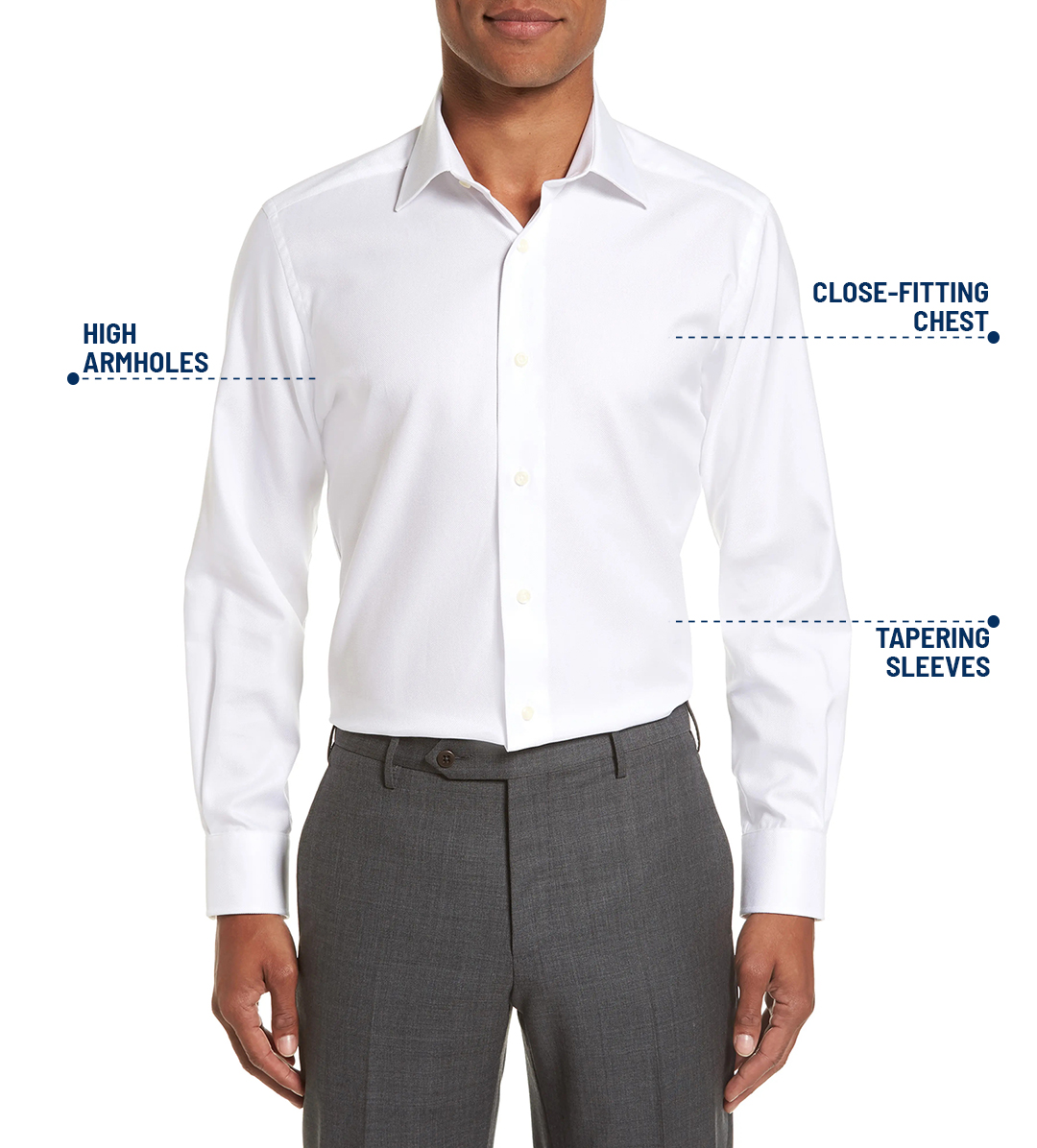
The typical slim-fit dress shirt features high armholes, tapering sleeves, a close-fitting chest, and back darts.
Although they appear more tapered to your body, comfort should still be a prerequisite with this shirt cut.
A slim-fit shirt is an ideal choice for lean or tall men. It’s also the best dress shirt fit to wear with modern or slim-fit suits.
Modern-Fit Dress Shirt
If the classic fit is vintage while a slim fit is fashion-forward for your style, a modern fit can be the ideal shirt cut.
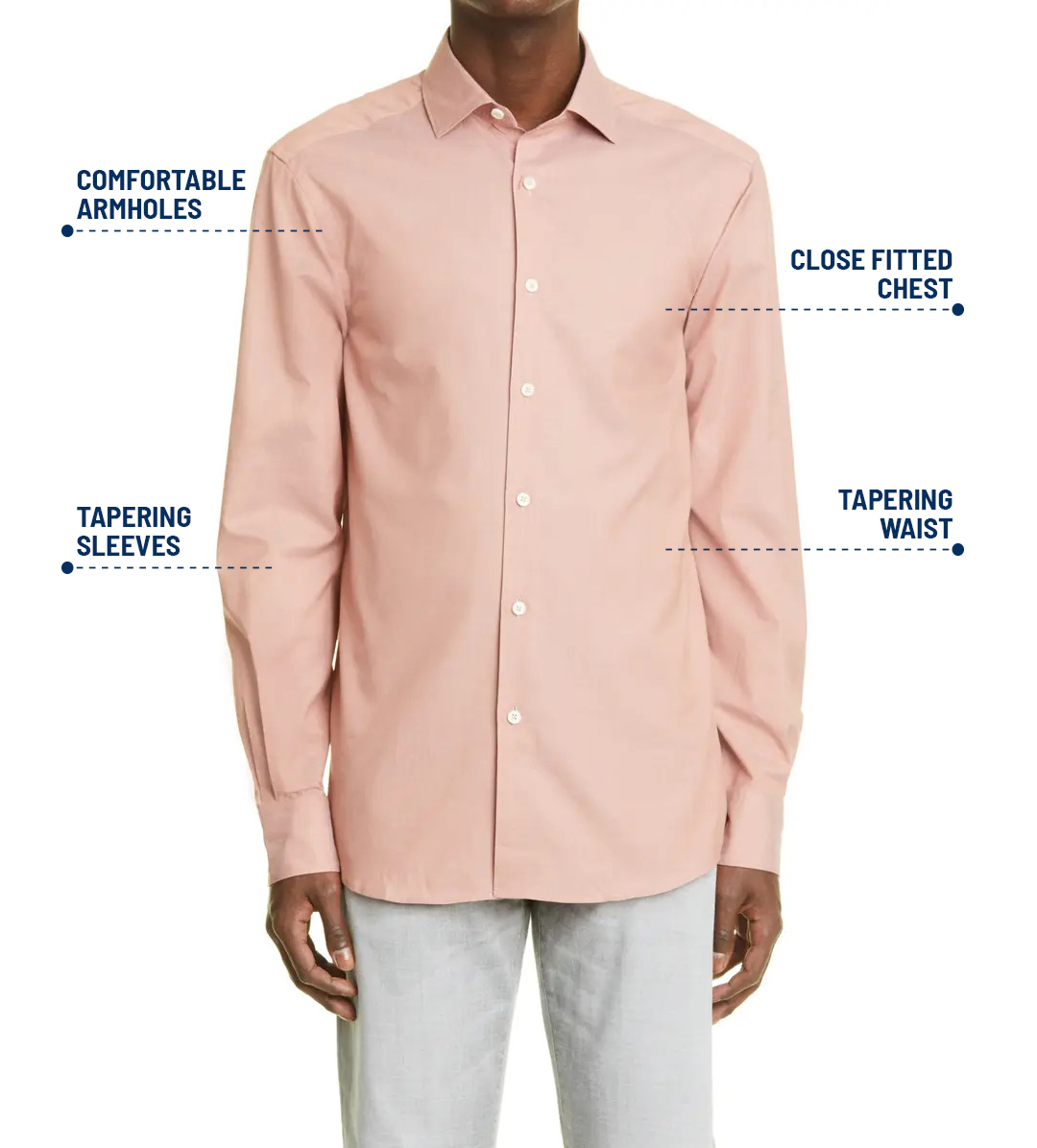
This dress shirt features lie between those of classic and slim-fit shirts.
The armholes, chest, waist, and sleeve are all elegant and appropriately comfortable but still tailored close enough to your body.
Most men look good in this shirt cut. However, older men should rather consider the regular cut.
Skinny-Fit Dress Shirt
The skinny dress shirts aim to create a trimmer silhouette and provide a fashion-forward approach that only lean gentlemen can carry.
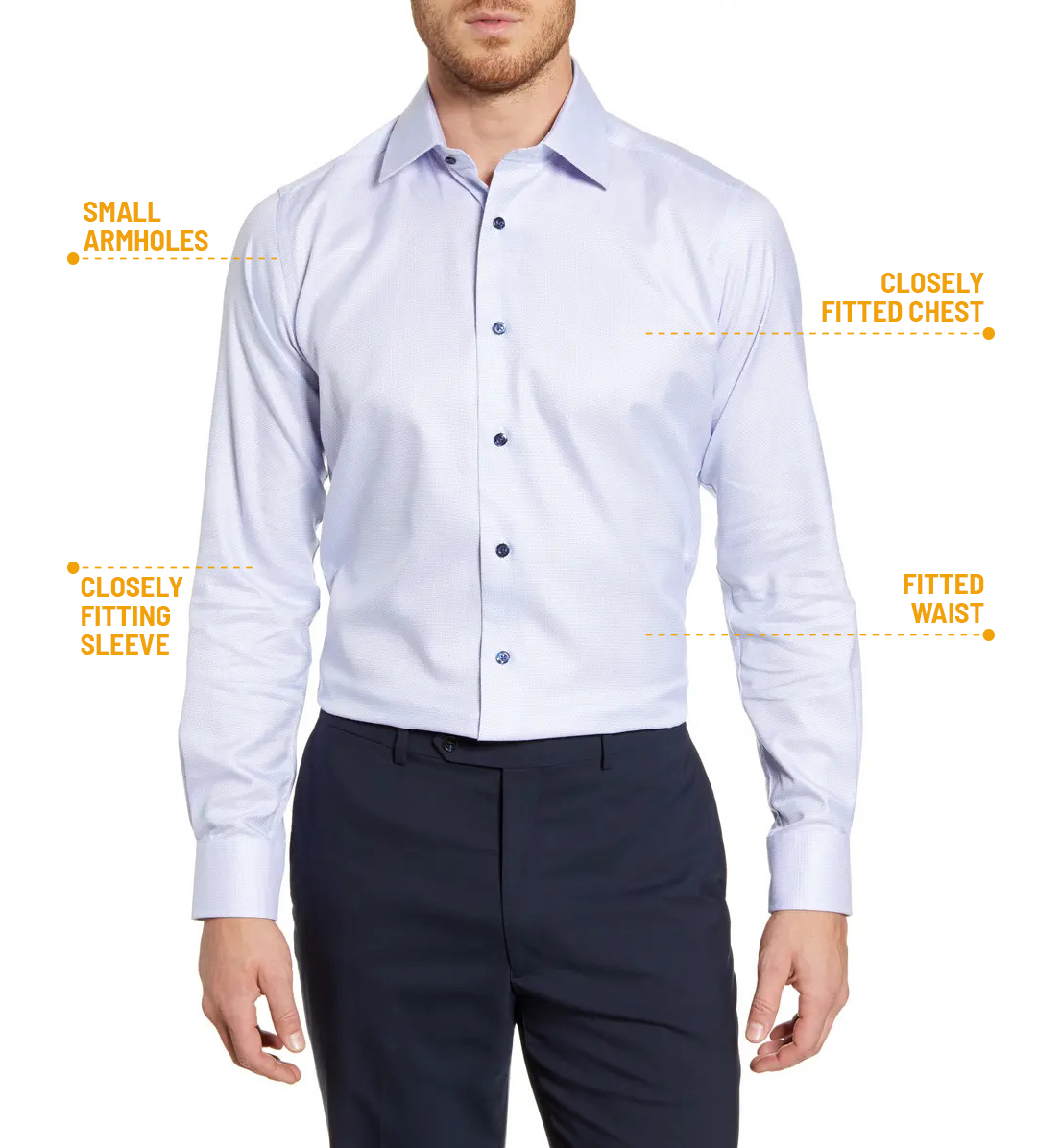
As a result, everything from the sleeves to the chest stays close to the body.
So wear this dress shirt if you are extremely confident about your body figure.

